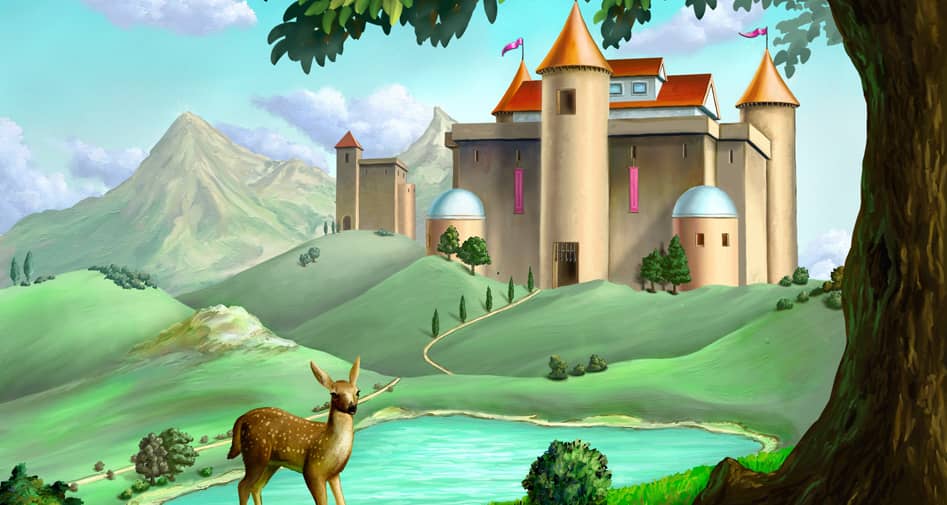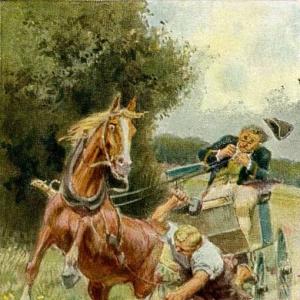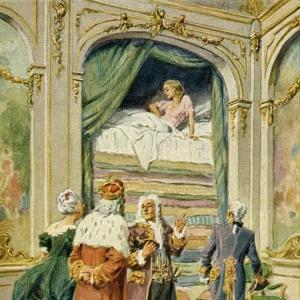Reading time: 4 min
The Lord God had created all animals, and had chosen out the wolf to be his dog, but he had forgotten the goat. Then the Devil made ready and began to create also, and created goats with fine long tails. Now when they went to pasture, they generally remained caught in the hedges by their tails, then the Devil had to go there and disentangle them, with a great deal of trouble. This enraged him at last, and he went and bit off the tail of every goat, as may be seen to this day by the stump. Then he let them go to pasture alone, but it came to pass that the Lord God perceived how at one time they gnawed away at a fruitful tree, at another injured the noble vines, or destroyed other tender plants. This distressed him, so that in his goodness and mercy he summoned his wolves, who soon tore in pieces the goats that went there. When the devil observed this, he went before the Lord and said, „Thy creatures have destroyed mine.“ The Lord answered, „Why didst thou create things to do harm?“ The Devil said, „I was compelled to do it: inasmuch as my thoughts run on evil, what I create can have no other nature, and thou must pay me heavy damages.“ – „I will pay thee as soon as the oak leaves fall; come then, thy money will then be ready counted out.“ When the oak-leaves had fallen, the Devil came and demanded what was due to him. But the Lord said, „In the church of Constantinople stands a tall oak-tree which still has all its leaves.“ With raging and curses, the Devil departed, and went to seek the oak, wandered in the wilderness for six months before he found it, and when he returned, all the oaks had in the meantime covered themselves again with green leaves. Then he had to forfeit his indemnity, and in his rage he put out the eyes of all the remaining goats, and put his own in instead. This is why all goats have devil’s eyes, and their tails bitten off, and why he likes to assume their shape.
 Learn languages. Double-tap on a word.Learn languages in context with Childstories.org and Deepl.com.
Learn languages. Double-tap on a word.Learn languages in context with Childstories.org and Deepl.com.Backgrounds
Interpretations
Adaptions
Summary
Linguistics
„The Lord’s Animals and the Devil’s“ is a lesser-known fairy tale collected by the Brothers Grimm, two German scholars named Jacob and Wilhelm Grimm. They were prominent linguists and cultural researchers who compiled and published various folktales and legends during the early 19th century. Their most famous collection, „Children’s and Household Tales“ (1812), also known as „Grimm’s Fairy Tales,“ features many well-known stories such as „Cinderella,“ „Hansel and Gretel,“ „Rapunzel,“ and „Snow White.“
The Brothers Grimm collected their tales from various sources, including oral accounts, written texts, and other storytellers. They sought to preserve traditional German folklore, which was at risk of being forgotten due to rapid industrialization and urbanization. Their work was part of the larger Romantic movement in Germany, which focused on the importance of cultural identity, history, and connection to nature.
„The Lord’s Animals and the Devil’s“ reflects the strong influence of Christian beliefs in European folklore, as it features the Lord God and the Devil as central characters. The story incorporates elements of religious morality and the eternal struggle between good and evil, which are common themes in the folktales and legends of the time.
Although not as popular as some of the other Grimm’s tales, „The Lord’s Animals and the Devil’s“ provides an interesting exploration of creation, the consequences of actions, and the origins of certain aspects of the natural world. It serves as an example of the richness and diversity of the stories collected by the Brothers Grimm, and its themes continue to resonate with readers today.
„The Lord’s Animals and the Devil’s“ can be interpreted in various ways, including as an exploration of the nature of good and evil, the power of creation, and the consequences of actions.
Good and Evil: The story juxtaposes the Lord’s creation of benevolent animals with the Devil’s creation of harmful goats, symbolizing the contrast between good and evil. The tale also portrays the struggle between these two forces, with the Lord trying to maintain harmony and the Devil causing chaos.
Power of Creation: The tale demonstrates that the nature of a creator affects their creations. The Lord, being good and kind, creates animals that are helpful and gentle. In contrast, the Devil’s malicious intentions result in the creation of goats that cause harm to the environment. This theme highlights the responsibility that comes with creation, as it can have lasting impacts on the world.
Consequences of Actions: The story emphasizes that actions have consequences, both intended and unintended. The Devil’s decision to create goats with long tails leads to his frustration and the eventual loss of their tails. Furthermore, his pursuit of compensation from the Lord ultimately backfires, resulting in the loss of his claim and the mutilation of the goats‘ eyes. This theme serves as a cautionary tale about the importance of considering the potential outcomes of one’s actions.
Trickery and Deception: The tale also explores the theme of trickery and deception, as seen in the Lord’s clever ploy to avoid compensating the Devil. By sending the Devil on a futile quest, the Lord exposes the Devil’s greed and vindictiveness while protecting His creation from further harm.
Origins and Explanations: Like many folktales and fairy tales, „The Lord’s Animals and the Devil’s“ serves to provide a creative explanation for certain aspects of the natural world. In this case, the story explains the unique appearance of goats, with their seemingly devilish eyes and short tails, as well as their association with the Devil in various cultures and mythologies.
„The Lord’s Animals and the Devil’s“ is a classic fairy tale that has been adapted in various forms of media. Here are a few notable adaptations:
Animated Films: The tale has been adapted into several animated films, including the Czechoslovakian film „The Devil and Kate“ and the Soviet film „The Cat Who Walked by Herself“. In both films, the story is given a whimsical treatment, with charming animations and lighthearted music.
Children’s Books: The story has been adapted into several children’s books, such as „The Cat and the Mouse and the Runaway Train“ by Peter Bently and Steve Cox, and „The Lord’s Animals and the Devil’s“ by John Yeoman and Quentin Blake. These adaptations often simplify the story for younger readers, while still retaining the tale’s original message.
Stage Plays: The tale has also been adapted into stage plays, such as „The Cat and the Mouse“ by James Reaney, which was performed in Canada in 1965. The play features a creative interpretation of the story, with actors playing the animals and engaging in a series of comical battles.
Television Shows: The tale has been adapted into several television shows, such as „Faerie Tale Theater“ and „Jim Henson’s The Storyteller“. These adaptations often feature well-known actors and elaborate sets, and are aimed at both children and adults.
Overall, „The Lord’s Animals and the Devil’s“ has proven to be a popular tale that continues to inspire new adaptations in various forms of media.
„The Lord’s Animals and the Devil’s“ is a Brothers Grimm fairy tale that tells the story of the creation of animals by both the Lord God and the Devil. After creating all animals, the Lord God forgets to create goats, so the Devil takes the opportunity to create them. He gives them long tails, but these tails get caught in hedges, causing the Devil much trouble. Frustrated, he bites off their tails, leaving only a stump.
The goats, now tailless, are allowed to graze freely, but they damage trees, vines, and other plants. This distresses the Lord, who summons wolves to protect the plants by attacking the goats. The Devil complains to the Lord, blaming Him for the destruction of his creatures and demanding compensation. The Lord agrees to pay the Devil when the oak leaves fall.
However, when the leaves fall, the Lord tells the Devil about an oak tree in Constantinople that still has its leaves. The Devil searches for this tree for six months, but when he returns, all the oaks have regrown their leaves, causing him to lose his claim for compensation. In his anger, the Devil blinds the remaining goats and replaces their eyes with his own, giving them their distinct appearance. This tale explains why goats have devilish eyes, short tails, and are often associated with the Devil himself.
The Brothers Grimm fairy tale „The Lord’s Animals and the Devil’s“ is rich in thematic and linguistic elements that offer insight into the moral and societal underpinnings of the story.
Characterization and Moral Dichotomy: The tale sets up a direct opposition between divine and diabolical forces, represented by the Lord God and the Devil. This dualism is reflected in the actions and creations of both characters: the Lord’s creations are depicted as inherently good or at least neutral, while the Devil’s creations are flawed and troublesome. The wolf is chosen as the Lord’s dog, indicating loyalty and servitude. In contrast, the goats, created by the Devil, are described as mischievous and destructive, aligning with the moral association of the Devil with chaos and harm.
Symbolism
Goats: The goats symbolize stubbornness and destruction. The tale explains their naturally short tails and „devil’s eyes“ as a consequence of their creation by the Devil, cementing their symbolic association with mischief and evil.
Trees and Leaves: The oak tree’s leaves are used as a divine loophole to avoid paying the Devil, symbolizing wisdom, patience, and the cyclical nature of time.
Narrative Structure and Conflict: The story follows a classic conflict-resolution structure, with the Devil’s dissatisfaction and deception forming the central conflict. The tale resolves with a clever twist that leaves the Devil defeated and humiliated. The dialogue between the Lord and the Devil introduces a moral argument about the nature of creation and the responsibility of the creator, serving to emphasize the moral lesson of the story: the inevitability of good overcoming evil.
Linguistic Style: The language is formal and archaic, typical of the Brothers Grimm narratives, with phrases such as „Thy creatures have destroyed mine“ and „Why didst thou create things to do harm?“
– Use of direct dialogue is minimal but impactful, reinforcing the interactions between divine and diabolic forces.
Themes
Good versus Evil: The tale centers on the eternal battle between good (represented by the Lord) and evil (represented by the Devil), a recurring theme in many Grimm stories.
Deception and Cleverness: The Lord’s promise to pay only after the oak leaves fall is a clever ruse demonstrating the triumph of wit over brute force or malevolence.
Overall, this fairy tale employs narrative techniques typical of the Brothers Grimm, including moral lessons, symbolic characters, and linguistic elements that engage with themes of good versus evil. The story exemplifies how traditional folklore combines entertainment with moral instruction, often through allegories that reflect societal values and beliefs.
Information for scientific analysis
Fairy tale statistics | Value |
|---|---|
| Number | KHM 148 |
| Translations | DE, EN, DA, ES, FR, PT, IT, JA, NL, PL, RU, TR, VI, ZH |
| Readability Index by Björnsson | 35.6 |
| Flesch-Reading-Ease Index | 76.7 |
| Flesch–Kincaid Grade-Level | 8.6 |
| Gunning Fog Index | 11.2 |
| Coleman–Liau Index | 8.1 |
| SMOG Index | 8.8 |
| Automated Readability Index | 9.9 |
| Character Count | 1.922 |
| Letter Count | 1.489 |
| Sentence Count | 15 |
| Word Count | 367 |
| Average Words per Sentence | 24,47 |
| Words with more than 6 letters | 41 |
| Percentage of long words | 11.2% |
| Number of Syllables | 457 |
| Average Syllables per Word | 1,25 |
| Words with three Syllables | 14 |
| Percentage Words with three Syllables | 3.8% |

 Facebook
Facebook  Whatsapp
Whatsapp  Messenger
Messenger  Telegram
Telegram Reddit
Reddit














